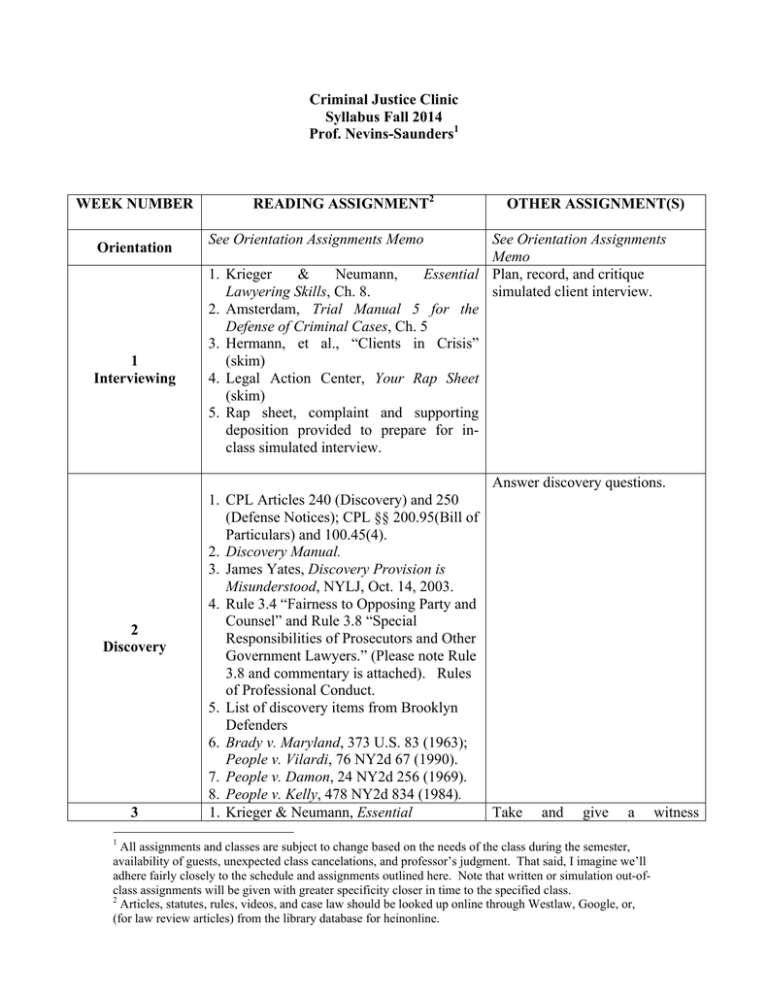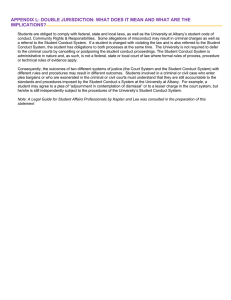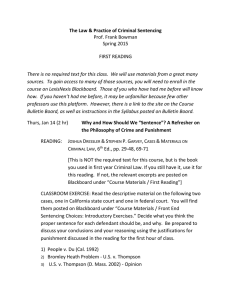Criminal Justice Clinic Syllabus Fall 2014 Prof. Nevins-Saunders
advertisement

Criminal Justice Clinic Syllabus Fall 2014 Prof. Nevins-Saunders1 READING ASSIGNMENT2 WEEK NUMBER Orientation See Orientation Assignments Memo 1. 2. 3. 1 Interviewing 4. 5. 2 Discovery 3 1 OTHER ASSIGNMENT(S) See Orientation Assignments Memo Krieger & Neumann, Essential Plan, record, and critique Lawyering Skills, Ch. 8. simulated client interview. Amsterdam, Trial Manual 5 for the Defense of Criminal Cases, Ch. 5 Hermann, et al., “Clients in Crisis” (skim) Legal Action Center, Your Rap Sheet (skim) Rap sheet, complaint and supporting deposition provided to prepare for inclass simulated interview. Answer discovery questions. 1. CPL Articles 240 (Discovery) and 250 (Defense Notices); CPL §§ 200.95(Bill of Particulars) and 100.45(4). 2. Discovery Manual. 3. James Yates, Discovery Provision is Misunderstood, NYLJ, Oct. 14, 2003. 4. Rule 3.4 “Fairness to Opposing Party and Counsel” and Rule 3.8 “Special Responsibilities of Prosecutors and Other Government Lawyers.” (Please note Rule 3.8 and commentary is attached). Rules of Professional Conduct. 5. List of discovery items from Brooklyn Defenders 6. Brady v. Maryland, 373 U.S. 83 (1963); People v. Vilardi, 76 NY2d 67 (1990). 7. People v. Damon, 24 NY2d 256 (1969). 8. People v. Kelly, 478 NY2d 834 (1984). 1. Krieger & Neumann, Essential Take and give a witness All assignments and classes are subject to change based on the needs of the class during the semester, availability of guests, unexpected class cancelations, and professor’s judgment. That said, I imagine we’ll adhere fairly closely to the schedule and assignments outlined here. Note that written or simulation out-ofclass assignments will be given with greater specificity closer in time to the specified class. 2 Articles, statutes, rules, videos, and case law should be looked up online through Westlaw, Google, or, (for law review articles) from the library database for heinonline. Investigation 2. 3. 4. 5. 6. 7. 8. 1. 2. 4 Motions 3. 4. 5. 1. 2. 5 Negotiation & Client Counseling Theory 3. 4. 6 Plea Negotiation & Client Counseling Simulation 1. Lawyering Skills, Ch. 9. C.P.L § 610. Andrea Lyon, Investigation and Development of a Theory. People v. Jesse Armstrong, N.Y.L.J. 11/16/95, p. 30, col. 5 (Sup. Ct. Queens Co., 1995)(Finnegan J.), aff’d, 249 A.D.2d 317 (2d Dept. 1998). John M. Lajoie, Criminal Defense Witness Interviews & Statements. Anthony Amsterdam, “Defense Investigation” in Trial Manual 5 for the Defense of Criminal Cases, pgs. 180-195 and Checklist ABA Criminal Defense Function Standards, Part IV: Investigation and Preparation, pgs. 201-203 Michelle Maxian, Subpoena Practice – (Skim this, but pay particular attention to the Introduction and sections I and IV) CPL §§ 170.30-170.45; 255; 710. Gary Muldoon, Handling a Criminal Case in New York (2012-13 ed.), Ch. 7 “Motion and Hearing Practice” People v. Mendoza, 82 N.Y.2d 415 (1993) People v. DeBour, 40 N.Y.2d 210 (1976) Hearing Preparation Handout Krieger & Neumann, Essential Lawyering Skills, Chapters 24-28. Joel Cohen, “When Defendants are Threatened to Plead Guilty.” http://www.stroock.com/SiteFiles/Pub99 4.pdf Rule 4.1 (and Comments thereto), “Truthfulness in Statements to Others” http://www.nycla.org/siteFiles/NYRuleso fProfessionalConduct4109_362.pdf Review PL 60, 65, 70 and 80 (only those sections applicable to misdemeanors), CPL 160.50, 170.55 and 170.56 – i.e. what are possible pleas? Discovery files for simulated plea negotiation statement. Draft motions facts section; answer questions about motions practice. Watch The Plea sections 2, 4, and 6 (or the whole thing). Two choices for viewing: http://video.pbs.org/video/221678 4391/ http://www.pbs.org/wgbh/pages/f rontline/shows/plea/view/ Draft negotiation strategy for current case using worksheet. Prepare for simulated negotiation and client counseling session. 7 Storytelling & Case Theory 8 Voir Dire 9 Openings 1. Kreiger & Neumann, Essential Lawyering Skills, Ch. 13, “The Story Model of Organizing Facts” 2. Alper et. al., Stories Told and Untold: Lawyering Theory Analysis of the First Rodney King Assault Trial,12 CLIN. L. REV. 1 (2005). 3. “Statement of the Case” and “Factual Background” in Respondent Edith Windsor’s Brief before the Supreme Court in United States of America v. Windsor, 2013 WL 701228 (2013). 4. Lindsay, Storytelling – Why We Do it and How to Get Better (optional) 5. “Argument I” in Brief for Appellants Oliver Brown et.al. before the Supreme Court in Brown v. Board of Educ. of Topeka, KS, 1952 WL 47265 (1952) (optional) 1. McElhaney, Rejiggering Jury Selection, ABA Journal, April 2008, 30-31. 2. Smith, Veteran Litigators Ignore Stereotypes, Knowing that Venire Members Will Weigh the Facts Against a Lifetime of Experiences, ABA Journal, pgs. 35-39 (March 2002) 3. Frederick, Mastering Voir Dire and Jury Selection, pgs. 1-12 (2005). 4. Kreiger and Richard K. Neumann, Jr., Essential Lawyering Skills, Ch. 13, §13.3. 1. Daniel Goleman, “Study Finds Jurors Often Hear Evidence with a Closed Mind,” New York Times, Nov. 29, 1994 (http://www.nytimes.com/1994/11/29/sc ience/study-finds-jurors-often-hearevidence-with-closedminds.html?pagewanted=all&src=pm). 2. Larry Pozner and Richard Dodd, Cross Examination Skills for Law Students, Ch. 7 (2009). 3. Steven H. Goldberg & Tracy W. McCormack, The First Trial: Where Do I Sit? What Do I Say? (2d. ed.) (2009), Ch. 8. Prepare and present a client narrative. Prepare voir dire questions. Prepare and present an opening argument. 10 Cross Examination 11 Crimmigration 12 Race/Policy 13 Sentencing 1. Public Defender Service for the District of Columbia, Criminal Practice Institute Manual, Ch. 26, “Cross-Examination” 2. Bergman, “Cross-Examination,” Trial Advocacy in a Nutshell 3. Pozner & Dodd, “The Only Three Rules of Cross-Examination,” CrossExamination: Skills for Law Students 4. Gideon’s Promise, “Cross Examination.” Prepare a cross witness narrative. 1. Immigrant Defense Project, Suggested Approaches for Reprseenting a Noncitizen in a Criminal Case 2. Immigrant Defense Project, Advisory for Hatian Nationals Consdiering Applying for TPS 3. Immigrant Defense Project, Practice Advisory: Duty of Criminal Defesne Counsel Representing an Immigrant Defendant after Padilla v. KY (Apr. 6, 2010) 4. Immigrant Defense Project, Practice Advisory: Descamps v. United States and the Modified Cateogrial Approach (July 17, 2013) 5. US Citizenship and Immigration Services Memo on “No Jail” or “No Incarceration” Certifications, (Jan. 21, 2011) 6. Manuel D. Vargas, Reprseenting Noncitizen Criminal Defendants in New York State, Ch. 3 (NYSDA Immigrant Defense Project) 7. Immigration and Naturalization Act §§ 212, 237 1. Murphy & Rosenbaum, “Two Women who Used Cocaine too Much: Class, Race, Gender, Crack, and Coke, Crack in America: Demon Drugs and Social Justice, pgs. 98-112 (1997). 2. Davis, Racial Fairness in the Criminal Justice System: the Role of the Prosecutor, 39 COLUM. HUM. RIGHTS L. REV. 202 (2007). 1. CPL §§ 380.10-380.50; 390.20-390.50 Draft a sentencing letter. 2. 3. 4. 5. 6. 14 How Can You Represent Those People? (focusing on statutory requirements) The Sentencing Project, Twelve Steps to Effective Sentencing Advocacy (found at http://sentencingproject.org/doc/publicat ions/twelvesteps.pdf) The Sentencing Project, The Thinking Advocate’s List of Mitigating Factors (found at http://lobby.la.psu.edu/049_Criminal_Ju stice_Reform/Organizational_Statement s/Sentencing%20Project/SP_Mitigating_ frna.pdf). Sentencing Letter for John Doe Sentencing Letter for John Smith Craig S. Cooley, Malvo Closing Argument, 19 CRIMINAL JUSTICE MAGAZINE, 1 (Spring 2004) (found at http://www.americanbar.org/publication s/criminal_justice_magazine_home/crim just_cjmag_19_1_juvenile.html). 1. Smith & Freedman (eds.), How Can You Draft and share personal narrative Represent Those People? (2013) (selected chapters). 2. Mary Halloran, An Ode to Criminal Lawyers, CALIFORNIA LAWYER, June 1998, at 96.



